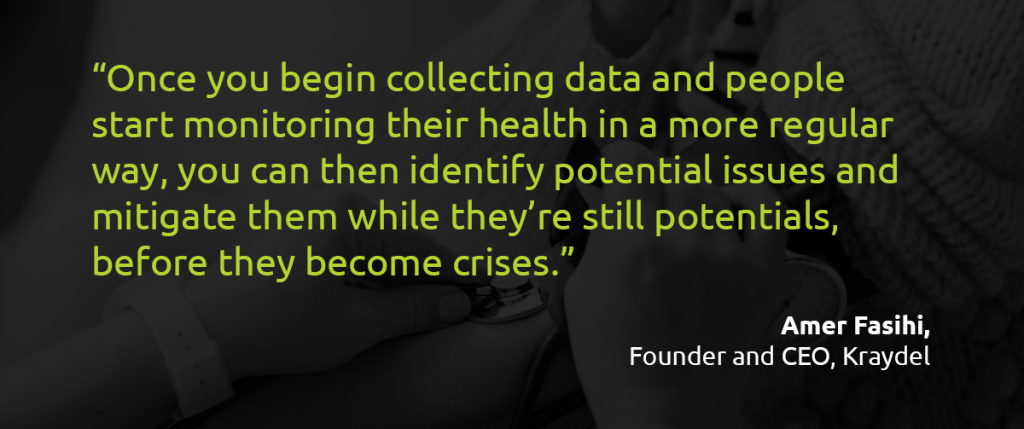The Future of Healthcare: Eldercare
Thanks to medical advancements, healthier lifestyles, and greater access to essentials like fresh food and water, people around the world are living longer, healthier lives. In 1980, the number of people over 60, worldwide, was just 382 million. By 2017, that had more than doubled to 962 million.1
As people live longer, the number of elderly individuals living with chronic conditions is also increasing, putting an additional burden on both public and private healthcare systems. The U.K. Department of Health estimated that 70% of England’s total healthcare spend is attributed to caring for people with long-term conditions.2 In the U.S., the Centers for Disease Control and Prevention (CDC) estimate is at 75%.3
The pain is personal as well. For example, my mother is 78, and as she’s less able to care for herself, more and more responsibility falls on me. I don’t live in the same city, let alone the same household, so I need to keep watch from afar. Anyone who’s ever cared for an aging parent from a distance knows how difficult this is to do.
So when we talk about eldercare, we’re not just talking about the elderly and professional caregivers. We’re also talking about the needs of personal caregivers, often immediate family members like me, as well as everyone else who has to take a backseat while we take care of our aging loved ones.
While the aging population brings a complex set of challenges, we see it as an opportunity to find solutions and bring people peace of mind as they face the impacts of eldercare.
During RGAX’s Future of Healthcare Roundtable Series on the topic of eldercare, I spoke with three notable healthcare technologists, Dr. James Somauroo, Amer Fasihi, and Max Parmentier, to explore the growing role of technology in this space. Here, I expand on our discussion to examine the challenges of eldercare, some impactful trends that are redefining how to approach caring for an aging population, and how agetech and insurtech are helping older adults and the people who care for them.

What is Eldercare?
Experts agree that the term eldercare is often oversimplified. In reality, eldercare is a large and variable sector that addresses the healthcare needs of both frail and healthy older adults. The demand for eldercare programs and services is growing rapidly, thanks to the demographic shifts and the increase in chronic conditions I’ve already mentioned.
Not only is the definition of elderly changing, but so too is the definition of care. Chronic conditions don’t always require hospitalization or institutionalized living. In a survey conducted by the AARP, 87% of people over 65 expressed a desire to “age in place,” increasing the need for qualified home healthcare providers.4
In 2020, the COVID-19 pandemic accelerated the demand for home healthcare, especially among the elderly. Older adults rarely fare well with respiratory diseases, but this one hit the elderly population harder than past outbreaks. According to the CDC, 8 out of 10 COVID-19 deaths in the U.S. were adults over 65.5

Elderly adults, whether vulnerable or healthy, are putting off routine visits to the doctor to avoid unnecessary exposure. To protect their loved ones, families are also opting to care for aging family members at home. Data from June 2020 revealed a 10% decline in nursing home residents that was only partially due to the tens of thousands of COVID-19 deaths in the elderly nursing home population.6
On a brighter note, smartphone usage is growing among older adults. In the U.S., the percentage of adults over 50 who own a smartphone increased from 53% in 2015 to 67% in 2018. The U.K. saw similar growth: from 44% to 60%. South Korea leads the way with 91% of adults over 50 owning smartphones.7
In these economies, a growing acceptance of telemedicine is providing seniors and other vulnerable adults with convenient, remote access to doctors, pharmacists, and behavioral health professionals. However, telemedicine is not without its challenges. Even when video is available, it doesn’t provide physicians and other healthcare professionals the same ability to observe the patient as an in-person visit. Unless a monitoring device is used, patients are often self-reporting vital signs like weight, blood pressure, and heart rate.
The Problem is Complex
Individuals and organizations focused on care for the elderly face several issues, and these challenges are exacerbated by an increase in demand for services and a decrease in funding. Some of the primary issues include:
- Shortage of caregivers – By 2030, there could well be a shortage of 15 million healthcare workers worldwide.8 Developed economies, in which individuals tend to live longer, are likely to be hardest hit. Emerging economies will also struggle as limited resources are prioritized away from services for aging adults.
- Increased family burdens – An estimated 77 million Americans of working age (18 to 64) identify as “unpaid family caregivers.” Approximately 80% of currently active caregivers, about 43 million, also work full time, and more caregivers than ever are caring for elderly family members and children at the same time.9
With more elderly adults remaining in their homes longer, family caregiver burnout is a real problem. TCare helps professional caregivers recognize the signs of burnout and intervene before the problem becomes a crisis. Central Illinois Agency in Aging found that in as few as six months after a TCare intervention, 84% of caregivers reported lower levels of stress and depression.
- Lack of EHR interoperability – More emphasis is being placed on electronic health records (EHR), but operability between systems is still lacking. For example, a dermatologist treating a new patient for a skin condition may not be able to see that the patient is also a diabetic. Elderly patients, not understanding the importance of seemingly unrelated health histories, may not volunteer critical information. And because physicians are being asked to see more patients in a day, they may not have time to gather the data through inquiry.
- Changing regulations – Keeping up with changing regulations can also be a challenge for healthcare providers. For example, in the U.S., the new Patient-Driven Groupings Model (PDGM) has dramatically changed the documentation requirements and reimbursement model for home healthcare.
- Slow pace of change – Because of the costs involved, publicly-funded health systems can be slower to adopt new ways of doing things than private healthcare systems. For example, Medicare only covers home healthcare if the patient can’t physically get to a provider without “taxing effort.” This means an elderly patient with a non-debilitating chronic condition may not qualify for home healthcare services even though their underlying condition and their age place them in the vulnerable category for COVID-19. It wasn’t until March 2020 that Centers for Medicare & Medicaid Services (CMS) extended Medicare to cover telehealth services for older adults. Even then, the changes enacted were positioned as being temporary.
- Slow technology adoption – While the percentage of older adults comfortable with using a smartphone and healthtech is growing, high adoption rates are not universal. For example, in 2017, many emerging economies had a dramatically lower percentage of adults over 50 owning smartphones: India (8%), Mexico (30%), Brazil (32%).10
K4Connect began life as a developer of solutions for smart homes until their CEO met a man with multiple sclerosis who helped him see how their technologies could empower older adults and those living with disabilities. Their flagship solution, K4 Community, provides long-term care residents with smart solutions to promote engagement, wellness, and a better quality of life while providing insights for facility staff and operators to help them provide more effective care.
- Focus on the physical – With so much focus on the physical care needs of an aging population, it’s easy to forget their emotional needs. A study conducted by AARP found that social isolation poses the same risk to one’s health as smoking up to 15 cigarettes a day.11
Technology Rises to the Occasion
The dramatic growth in the eldercare market has attracted many innovators who are keen to challenge the status quo. From simple medical devices and products that support the activities of daily living to those predicting deterioration, innovations in agetech will undoubtedly help improve quality of life for older adults.
Join our community of innovators eager to transform the life insurance industry.
Subscribe to the RGAX blog >
[1]United Nations, World Population Aging, 2017, https://www.un.org/en/development/desa/population/publications/pdf/ageing/WPA2017_Highlights.pdf
[2]U.K. Policy Paper, Long Term Conditions Compendium of Information: Third Edition, May 2012, https://www.gov.uk/government/publications/long-term-conditions-compendium-of-information-third-edition
[3]National Association of Chronic Disease Directors, Why We Need Public Health to Improve Healthcare, Accessed August 2020, https://www.chronicdisease.org/page/whyweneedph2imphc
[4]National Conference of State Legislatures and the AARP Public Policy Institute, Aging in Place: A State Survey of Livability Policies and Practices, December 2011
[5] Centers for Disease Control and Prevention, Coronavirus Disease 2019 (COVID-19), Accessed August 2020, https://www.cdc.gov/coronavirus/2019-ncov/need-extra-precautions/older-adults.html
[6] Skilled Nursing News, Early Data Reveals 10% Nursing Home Census Drop, But COVID-19 Reporting Remains Incomplete, June 8, 2020 https://skillednursingnews.com/2020/06/early-data-reveals-10-nursing-home-census-drop-but-covid-19-reporting-remains-incomplete/
[7] Pew Research Center, Smartphone Ownership Is Growing Rapidly Around the World, but Not Always Equally, February 5, 2019, https://www.pewresearch.org/global/2019/02/05/smartphone-ownership-is-growing-rapidly-around-the-world-but-not-always-equally/
[8] LeadingAge Magazine, Worker Shortages Challenge Providers Worldwide, Vol 9, July-August 2019, https://www.leadingage.org/magazine/july-august-2019/Worker-Shortages-Challenge-Providers-Worldwide-V9N4
[9] LIMRA, The Financial Needs of Family Caregivers, June 20, 2019, https://www.limra.com/en/research/research-series/the-financial-needs-of-family-caregivers-series/
[10] Pew Research Center, Smartphone Ownership Is Growing Rapidly Around the World, but Not Always Equally, February 5, 2019, https://www.pewresearch.org/global/2019/02/05/smartphone-ownership-is-growing-rapidly-around-the-world-but-not-always-equally/
[11] AARP, AARP Foundation Draws Attention to Social Isolation with the Launch of Connect2Affect, December 2016, https://press.aarp.org/2016-12-07-AARP-Foundation-Draws-Attention-to-Social-Isolation-with-the-Launch-of-Connect2Affect

